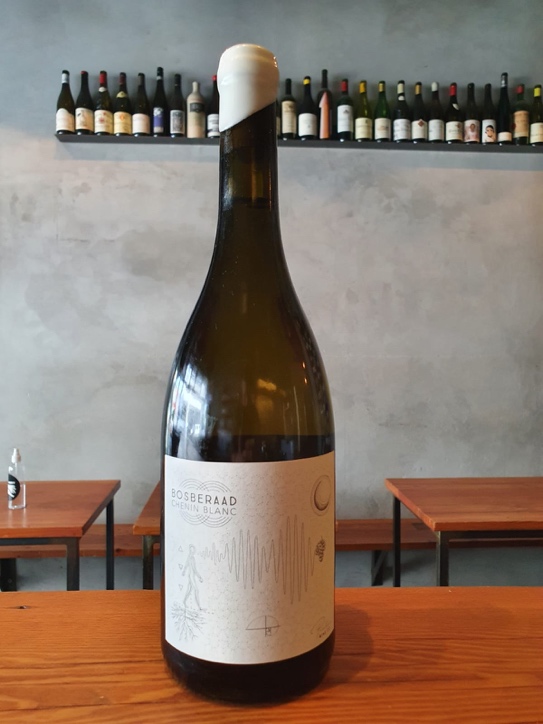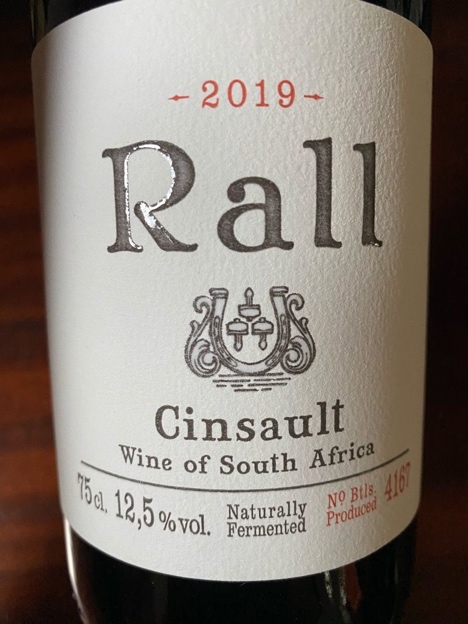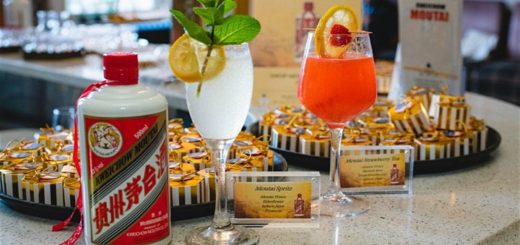Cape to Capezzana, Deliciousness from Unsung Grapes
Cult and under-the-radar. Three unique, incredible wines from South Africa’s Western Cape, and one classic producer in Tuscany delivering something surprising and special.
About the only thing we’ve domesticated longer than a grapevine is the dog. And whilst they are cute and clog up your phone’s photo gallery, they’re not much use in a lockdown. Grapes proved themselves man’s best friend this last year, providing the wholesome adventures a dog just can’t deliver after months trapped indoors.
Paulus Wine Co. ‘Bosberaad’ Chenin blanc 2018, W.O. Swartland, South Africa
 The team behind this wine are two Pauls – Pauline and Paul, hence Paulus Wine Company. And though they’d lament everyone’s immediate connotation of them with the Sadie Family Wines (whom the male Paul makes the world-famous wines for) there’s no doubt that, along with their plethora of harvesting experience, it lays the foundation for this lovely white wine. The vineyard is grown on the granitic Paardeberg in South Africa’s Swartland; the vines are old; and it’s a thoroughly competent example of the variety, showing a nose of white peach, pear, sea spray and to my mind – although the bottle may have been open for too long now – a delicious desiccated orange note. The palate is more fleshy than expected; it’s quite full with a zesty acidity that lingers for some time on your palate. Highly recommended. This company surely has a very prospective future ahead. This is a real hard-to-find gem worth grabbing if you see it.
The team behind this wine are two Pauls – Pauline and Paul, hence Paulus Wine Company. And though they’d lament everyone’s immediate connotation of them with the Sadie Family Wines (whom the male Paul makes the world-famous wines for) there’s no doubt that, along with their plethora of harvesting experience, it lays the foundation for this lovely white wine. The vineyard is grown on the granitic Paardeberg in South Africa’s Swartland; the vines are old; and it’s a thoroughly competent example of the variety, showing a nose of white peach, pear, sea spray and to my mind – although the bottle may have been open for too long now – a delicious desiccated orange note. The palate is more fleshy than expected; it’s quite full with a zesty acidity that lingers for some time on your palate. Highly recommended. This company surely has a very prospective future ahead. This is a real hard-to-find gem worth grabbing if you see it.
Van Loggerenberg Wines ‘Kameraderie’ Chenin blanc 2019, South Africa
 One of my favourite white wines coming from South Africa right now, from a stellar producer. Sadly the tiny vineyard this wine comes is proving precarious. Though tended dutifully by the winemaker, Lukas, it is equally well attended by sweet-toothed baboons. Add that to a drought stricken four years in the Western Cape and you’ve got a vineyard that barely produces a fruit yield even in the best of times. What a wine it is, though. Maybe the baboons sort out and eat all the bad grapes, but what’s left is almost distilled in its concentration. A Chenin blanc that’s equally viscous and refreshing. Aromatically it’s a heavyweight boxer, but not those big, slow ones. Prime Mike Tyson is analogous, or Anthony Joshua. The wine’s good heaps of flavour: peaches, citrus, orange peel, ginger… it’s a mélange. When you drink this wine, it’s fatty, almost oily feeling on your tongue, exuding flavour, but yet, all that acidity cleans up the cacophony like the final high pitched ring of the cello in a concerto.
One of my favourite white wines coming from South Africa right now, from a stellar producer. Sadly the tiny vineyard this wine comes is proving precarious. Though tended dutifully by the winemaker, Lukas, it is equally well attended by sweet-toothed baboons. Add that to a drought stricken four years in the Western Cape and you’ve got a vineyard that barely produces a fruit yield even in the best of times. What a wine it is, though. Maybe the baboons sort out and eat all the bad grapes, but what’s left is almost distilled in its concentration. A Chenin blanc that’s equally viscous and refreshing. Aromatically it’s a heavyweight boxer, but not those big, slow ones. Prime Mike Tyson is analogous, or Anthony Joshua. The wine’s good heaps of flavour: peaches, citrus, orange peel, ginger… it’s a mélange. When you drink this wine, it’s fatty, almost oily feeling on your tongue, exuding flavour, but yet, all that acidity cleans up the cacophony like the final high pitched ring of the cello in a concerto.
A flowery description I know, but the Kameraderie lives up to it. This sixty year old vineyard itself grows high in the hills above the historic region of Paarl. The altitude and scarcity of water in the boney soils create this concentrated yet tense wine that’s one of the best of the Cape.
Rall Cinsault 2019, W.O. Coastal Region, South Africa
 Now that Cinsault – an ‘heirloom’ red grape of South Africa, if ever there was one – has been allowed back into the vinous conversation at a serious level, it’s worth trying some better examples of this wine to see its potential. (Stereo)typically a wine known for unidimensional juicy red fruit flavours, too simple to be paired with anything but a swimming pool, the Rall seems to have a glimmer in its eye, suggesting, perhaps, it knows something we don’t. This is a tremendous example of Cinsault, and yes, it has plenty of juicy red fruit, but that’s just the invitation card. As you stick your nose farther into the glass, arresting aromatics of turkish delight, white pepper and even a graphite-y, pencil lead kind-of-thing comes at you. It’s truly a multidimensional wine that engages your cortex from more than a few angles. The wine’s palate is equally accomplished – it’s tangy and flavoursome, the tannic structure is serious and deep and that lovely fruity, spicy character sits on top of all of that. Make no mistake, this is still a light red wine, but like the best Pinot noirs, that means nothing in presence of the achievement. Technically speaking, it’s a blend of two old vineyards, one in Darling, the other slightly eastward in Swartland, and to my mind, it’s the best example of the grape coming out of South Africa. Search and destroy!
Now that Cinsault – an ‘heirloom’ red grape of South Africa, if ever there was one – has been allowed back into the vinous conversation at a serious level, it’s worth trying some better examples of this wine to see its potential. (Stereo)typically a wine known for unidimensional juicy red fruit flavours, too simple to be paired with anything but a swimming pool, the Rall seems to have a glimmer in its eye, suggesting, perhaps, it knows something we don’t. This is a tremendous example of Cinsault, and yes, it has plenty of juicy red fruit, but that’s just the invitation card. As you stick your nose farther into the glass, arresting aromatics of turkish delight, white pepper and even a graphite-y, pencil lead kind-of-thing comes at you. It’s truly a multidimensional wine that engages your cortex from more than a few angles. The wine’s palate is equally accomplished – it’s tangy and flavoursome, the tannic structure is serious and deep and that lovely fruity, spicy character sits on top of all of that. Make no mistake, this is still a light red wine, but like the best Pinot noirs, that means nothing in presence of the achievement. Technically speaking, it’s a blend of two old vineyards, one in Darling, the other slightly eastward in Swartland, and to my mind, it’s the best example of the grape coming out of South Africa. Search and destroy!
Image credit: www.cellartracker.com
Capezzana Trebbiano 2015, Tuscany
 What a lovely surprise this wine is. Firstly, Capezzana knows that Trebbiano is no-one’s favourite grape. It’s tastes thin and goes well with fish. That’s the line; that’s how the world knows this sack of sugar. This one is different though. And it was a double surprise, given the wine already had six years of aging behind it and was in delightful shape (much better than a couple seriously high end wines tried that same night!).
What a lovely surprise this wine is. Firstly, Capezzana knows that Trebbiano is no-one’s favourite grape. It’s tastes thin and goes well with fish. That’s the line; that’s how the world knows this sack of sugar. This one is different though. And it was a double surprise, given the wine already had six years of aging behind it and was in delightful shape (much better than a couple seriously high end wines tried that same night!).
Capezzana train their vineyards to produce quality trebbiano, not quantity trebbiano (the ubiquitous default). A risky move as no one pays a premium for this grape. It’s also aged in oak barrels, unlike mass production steel tanks. The result is a wine that’s appealingly aromatic – lots of white pome fruits and some stone fruit. The extra age had given a lovely oxidative, apricot edge to the wine. The palate is full and flavourful with a satisfying tang of acidity. Not the thin, short lived usual rendition of the variety. Really delicious stuff, from the world’s most abused grape.




